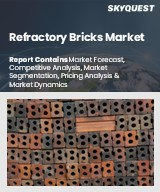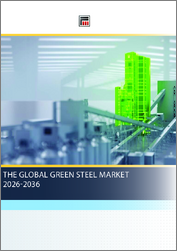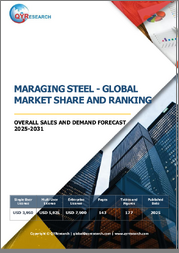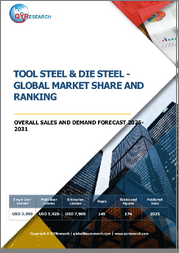
|
시장보고서
상품코드
1748472
유럽의 광업 및 철강업 : 최종 용도별, 제조 방법별, 최종 제품별, 국가별 분석과 예측(2025-2035년)Europe Mining Steel Industry Market: Focus on End-User Application, Production Methodology, End Products, and Country - Analysis and Forecast, 2025-2035 |
||||||
유럽의 광업 및 철강업 시장 규모는 2024년 1,242억 달러에서 CAGR 5.17%로 성장하여 2035년에는 2,176억 달러 규모로 성장할 것으로 예상됩니다.
유럽 철강 시장은 인프라, 자동차, 건설 등 주요 산업의 수요 증가로 인해 견조한 성장세를 보이고 있습니다. 이 지역에서는 전기 아크로(EAF), 직접환원철(DRI) 기술 사용 확대, 재생에너지 도입 등 환경 친화적 제조를 위한 노력이 이러한 추세를 뒷받침하고 있습니다. 이러한 발전을 뒷받침하기 위해 유럽에서는 원료탄, 철광석 등 원료 공급망에 대한 투자가 증가하고 있으며, 철강 제조 기술도 비약적으로 발전하고 있습니다. 업계가 저탄소, 에너지 효율적인 제철로의 전환을 가속화하고 있는 가운데, 유럽은 향후 몇 년 동안 세계 광업 및 철강업에서 입지를 확고히 할 수 있는 좋은 위치에 있습니다.
| 주요 시장 통계 | |
|---|---|
| 예측 기간 | 2025-2035년 |
| 2025년 평가 | 1,315억 달러 |
| 2035년 예측 | 2,176억 달러 |
| CAGR | 5.17% |
유럽의 광업 및 철강업은 이 지역의 인프라, 산업 기반 성장 및 저탄소 경제로의 전환에 필수적입니다. 유럽 철강 시장은 기계, 건축, 에너지, 자동차 등 주요 산업의 수요에 힘입어 경제 활동의 중요한 구성요소로 자리 잡고 있습니다. 이 지역이 수입에 의존하고 있음에도 불구하고, 광업 부문은 철광석, 원료탄, 주요 광물을 포함한 중요한 원자재의 안정적인 공급을 보장하고 있습니다.
기후 목표와 환경 규제가 이 사업의 대대적인 전환을 촉진하고 있습니다. 전기 아크로(EAF), 수소 기반 직접환원철(DRI), 철강 재활용과 같은 순환 경제 기술은 유럽 철강 제조업체들이 단계적으로 도입하고 있는 지속가능한 제조 기술 중 하나입니다. 이러한 노력은 Fit for 55 패키지 및 Green Deal과 같은 산업 회복력을 향상시키고 탄소배출량을 줄이는 것을 목표로 하는 EU의 정책적 프레임워크에 부합합니다.
자동화, 디지털화, 기술 혁신은 모두 가치사슬 전반의 제조성과 경쟁력 향상에 기여하고 있습니다. 그러나 에너지 비용 상승, 국제 무역의 압력, 규제 준수 등은 기업이 직면한 어려움 중 일부입니다. 이러한 장애물에도 불구하고 유럽의 광업 및 철강업은 현명한 투자, 법적 지원, 지속가능한 재료에 대한 수요 증가에 힘입어 지속적으로 확장하고 있습니다.
세분화 1 : 최종 용도별
- 운송(자동차 및 기타 운송)
- 건축 및 건설·인프라
- 소비재·가전
- 산업 설비 및 제조
- 포장
- 기타
세분화 2 : 제조 방식별
- 고로-기초산소로(BF-BOF)
- 직접환원철-전기 아크로(DRI-EAF)
- 기타 신기술
세분화 3 : 최종 제품별
- 탄소강
- 합금강
- 스테인리스강
- 고강도강
- 기타
세분화 4 : 지역별
- 독일, 프랑스, 오스트리아, 이탈리아, 영국, 기타
유럽 광업 및 철강업 시장 동향과 촉진요인 및 과제
동향
- EAF와 수소 기반 DRI를 통한 저탄소 철강 생산으로의 전환
- 재활용 철강 사용 및 순환 경제 관행의 증가
- AI, 자동화, IoT 등 디지털 기술의 채광 및 제철 플랜트 도입
- 건설, 자동차, 신재생에너지 부문의 수요 증가
- 원자재 확보를 위한 전략적 파트너십 및 합작 투자
- 수입 의존도를 낮추기 위해 국내 광업에 대한 투자 증가
촉진요인
- 탈탄소화를 촉진하는 EU Green Deal과 Fit for 55 이니셔티브
- 고품질의 지속가능한 방식으로 생산되는 철강에 대한 수요가 급증
- 그린스틸 기술에 대한 정부의 우대 및 자금 지원
- 인프라 개발 및 재생에너지 도입 확대
- 전기자동차 생산 확대가 첨단 철강 수요를 촉진
- 제조의 자원 효율성과 에너지 최적화에 대한 중요성
과제
- 세계 경쟁사 대비 높은 에너지 비용 및 운영비 절감 효과
- 환경 및 탄소 컴플라이언스를 둘러싼 복잡한 규제
- 철광석, 원료탄 등 수입 원자재에 대한 높은 의존도
- 세계 철강 생산능력 과잉과 관세로 인한 무역 압력
- 청정 제조 기술에 대한 대규모 투자 필요성
- 디지털 전환에 적응하는 데 필요한 인력의 기술력 향상
유럽의 광업 및 철강업에 대해 조사했으며, 주요 동향, 시장 영향요인 분석, 기술·특허 분석, 제조 동향, 법·규제 환경, 시장 규모 추정 및 예측, 각종 부문별·주요 국가별 상세 분석, 경쟁 상황, 주요 기업 프로파일 등을 정리하여 전해드립니다.
목차
주요 요약
범위와 정의
제1장 시장
- 동향 : 현황과 향후에 대한 영향 평가
- 광업 및 철강 제조 공정 자동화
- 신흥 시장으로부터의 수요 증가
- 공급망 개요
- 밸류체인 분석
- 공급망 제약
- 가격 분석
- 마켓 맵(밸류체인 전체의 이해관계자 매핑)
- 특허 출원 동향(국가·기업별)
- 시장 역학 개요
- 시장 성장 촉진요인
- 시장 성장 억제요인
- 시장 기회
- 철강 제조 시나리오
- 제조능력 전망
- 규제 상황
- 이해관계자 분석
- 제조 공정별 설비 용량(용광로-BOF 및 DRI-EAF)
- 향후 프로젝트와 용량 증가
- 진행중인 투자
- 스크랩 재활용 시장 개요
- 배출 저감 이니셔티브(광업에서 철강업으로의 이동)
- 그린 스틸 시장 전망
- 시장 규모와 성장 예측
- 그린 스틸이 기존 철강 시장에 미치는 영향
- 그린 스틸 도입 과제와 촉진요인
- 주요 그린 스틸 프로젝트와 이니셔티브
제2장 지역
- 지역 요약
- 유럽
- 시장
- 용도
- 제품
- 광업 및 철강업 제조 시나리오
- 유럽(국가별)
제3장 시장 : 경쟁 벤치마킹과 기업 개요
- 다음 프론티어
- 지리적 평가
- 기업 개요
- ArcelorMittal
- thyssenkrupp AG
- Salzgitter AG
제4장 조사 방법
ksm 25.06.24Introduction to Europe Mining Steel Industry Market
The Europe mining steel industry market was valued at $124.2 billion in 2024 and is projected to grow at a CAGR of 5.17%, reaching $217.6 billion by 2035. The steel market in Europe is expanding steadily due to increased demand from important industries like infrastructure, automotive, and construction. The region's drive for greener manufacturing-which includes a greater use of electric arc furnaces (EAF), direct reduced iron (DRI) technology, and the incorporation of renewable energy sources-supports this trend. In order to support these developments, Europe is seeing an increase in investment in supply networks for raw materials, such as coking coal and iron ore, as well as breakthroughs in steel production techniques. Europe is well-positioned to solidify its place in the global mining and steel scene in the upcoming years as the industry quickens its shift to low-carbon and energy-efficient steelmaking.
Market Introduction
| KEY MARKET STATISTICS | |
|---|---|
| Forecast Period | 2025 - 2035 |
| 2025 Evaluation | $131.5 Billion |
| 2035 Forecast | $217.6 Billion |
| CAGR | 5.17% |
The mining and steel sector in Europe is essential to the growth of the region's infrastructure, industrial base, and shift to a low-carbon economy. The European steel market continues to be a vital component of economic activity, driven by demand from important industries like machinery, building, energy, and automobiles. Despite the region's continued reliance on imports, the mining sector guarantees a steady supply of vital raw materials including iron ore, coking coal, and key minerals.
Climate goals and environmental rules are driving a substantial transition in the business. Electric arc furnaces (EAF), hydrogen-based direct reduced iron (DRI), and circular economy techniques like steel recycling are among the sustainable production techniques that European steelmakers are progressively implementing. These initiatives are in line with EU policy frameworks that aim to improve industrial resilience and reduce carbon emissions, such as the Fit for 55 package and the Green Deal.
Automation, digitisation, and technological innovation are all contributing to increased productivity and competitiveness throughout the value chain. High energy costs, pressures from international trade, and regulatory compliance are some of the difficulties the business faces, though. Notwithstanding these obstacles, the mining and steel sector in Europe is poised for sustained expansion, bolstered by smart investments, legislative backing, and the growing need for sustainable materials.
Market Segmentation
Segmentation 1: by End-Use Application
- Transportation (Automotive and Other Transportation)
- Building, Construction, and Infrastructure
- Consumer Goods and Appliances
- Industrial Equipment and Manufacturing
- Packaging
- Others
Segmentation 2: by Production Methodology
- Blast Furnace-Basic Oxygen Furnace (BF-BOF)
- Direct Reduced Iron - Electric Arc Furnace (DRI-EAF)
- Other Emerging Technologies
Segmentation 3: by End Products
- Carbon Steel
- Alloy Steel
- Stainless Steel
- High-Strength Steel
- Others
Segmentation 4: by Region
- Europe: Germany, France, Austria, Italy, U.K., and Rest-of-Europe
Europe Mining Steel Industry Market Trends, Drivers and Challenges
Trends
- Shift toward low-carbon steel production using EAFs and hydrogen-based DRI
- Increasing use of recycled steel and circular economy practices
- Adoption of digital technologies like AI, automation, and IoT in mining and steel plants
- Growth in demand from construction, automotive, and renewable energy sectors
- Strategic partnerships and joint ventures for raw material security
- Rising investment in domestic mining to reduce reliance on imports
Drivers
- EU Green Deal and Fit for 55 initiative pushing for decarbonization
- Strong demand for high-quality, sustainably produced steel
- Government incentives and funding for green steel technologies
- Growing infrastructure development and renewable energy installations
- Expansion of electric vehicle production boosting advanced steel demand
- Focus on resource efficiency and energy optimization in manufacturing
Challenges
- High energy and operational costs compared to global competitors
- Regulatory complexities around environmental and carbon compliance
- Dependency on imported raw materials like iron ore and coking coal
- Trade pressures due to global steel overcapacity and tariffs
- Need for large-scale investment in clean production technologies
- Workforce upskilling required to adapt to digital transformation
How can this report add value to an organization?
Product/Innovation Strategy: The Europe mining steel industry market is segmented based on various applications, production methodology, and end-products, which provides valuable insights. By end-use application segment includes transportation (automotive and other transportation), building, construction, and infrastructure, consumer goods and appliances, industrial equipment and manufacturing, packaging, and others. By production methodology, the market is categorized into a blast furnace-basic oxygen furnace (BF-BOF), direct reduced iron-electric arc furnace (DRI-EAF), and other emerging technologies. Lastly, the end products include carbon steel, alloy steel, stainless steel, high-strength steel, and others.
Growth/Marketing Strategy: The Europe mining steel industry market has been growing. The market offers enormous opportunities for existing and emerging market players. Some of the strategies covered in this segment are mergers and acquisitions, product launches, partnerships and collaborations, business expansions, and investments. The strategies preferred by companies to maintain and strengthen their market position primarily include product development.
Competitive Strategy: The key players in the Europe mining steel industry market analyzed and profiled in the study include professionals with expertise in the mining and steel industry. Additionally, a comprehensive competitive landscape such as partnerships, agreements, and collaborations are expected to aid the reader in understanding the untapped revenue pockets in the market.
Key Market Players and Competition Synopsis
The companies that are profiled in the Europe mining steel industry market have been selected based on inputs gathered from primary experts who have analyzed company coverage, product portfolio, and market penetration.
Some of the prominent names in this market are:
- ArcelorMittal
- thyssenkrupp AG
- Salzgitter AG
Table of Contents
Executive Summary
Scope and Definition
1 Markets
- 1.1 Trends: Current and Future Impact Assessment
- 1.1.1 Automation in Mining and Steel Production Processes
- 1.1.2 Increased Demand from Emerging Markets
- 1.2 Supply Chain Overview
- 1.2.1 Value Chain Analysis
- 1.2.1.1 Key Iron Ore Producing Nations and Mining Capacity
- 1.2.1.2 Key Coking Coal Exporting Nations
- 1.2.2 Supply Chain Constraints
- 1.2.3 Pricing Analysis
- 1.2.4 Market Map (Stakeholder Mapping across Value Chain)
- 1.2.1 Value Chain Analysis
- 1.3 Patent Filing Trend (by Country, Company)
- 1.4 Market Dynamics Overview
- 1.4.1 Market Drivers
- 1.4.1.1 Urbanization and Infrastructure Growth
- 1.4.1.2 Public-Private Investments in Infrastructure
- 1.4.2 Market Restraints
- 1.4.2.1 Volatility in Raw Material Prices
- 1.4.2.2 Geopolitical and Trade Tensions
- 1.4.3 Market Opportunities
- 1.4.3.1 Growing Demand for Specialty Steel Products
- 1.4.3.2 Technological Innovation in Steelmaking
- 1.4.1 Market Drivers
- 1.5 Steel Production Scenario
- 1.5.1 Production Capacity Outlook (2024-2034)
- 1.5.2 Regulatory Landscape
- 1.5.3 Stakeholder Analysis
- 1.5.4 Installed Capacity by Production Process (Blast Furnace-BOF and DRI-EAF)
- 1.5.5 Upcoming Projects and Capacity Additions (2025-2035)
- 1.5.6 Ongoing Investments
- 1.5.7 Scrap Recycling Market Overview
- 1.5.8 Emission Reduction Initiatives (Mining Steel Industry Transition)
- 1.6 Green-Steel Market Outlook
- 1.6.1 Market Size and Growth Forecast (2024-2034)
- 1.6.2 Impact of Green Steel on Conventional Steel Market
- 1.6.3 Challenges and Enablers for Green-Steel Adoption
- 1.6.4 Key Green-Steel Projects and Initiatives
2 Regions
- 2.1 Regional Summary
- 2.2 Europe
- 2.2.1 Markets
- 2.2.1.1 Key Market Participants in Europe
- 2.2.1.2 Driving Factors for Market Growth
- 2.2.1.3 Factors Challenging the Market
- 2.2.2 Application
- 2.2.3 Product
- 2.2.4 Mining-Steel Industry Production Scenario
- 2.2.5 Europe (by Country)
- 2.2.5.1 Germany
- 2.2.5.1.1 Application
- 2.2.5.1.2 Product
- 2.2.5.1.3 Installed Capacity and Production by Process
- 2.2.5.1.3.1 Upcoming Projects
- 2.2.5.1.3.2 Ongoing Investments
- 2.2.5.1.3.3 Scrap Recycling Overview
- 2.2.5.1.4 Raw Material Analysis (Iron Ore, Coking Coal, Scrap)
- 2.2.5.1.4.1 Consumption by Key Companies
- 2.2.5.1.4.2 Import Locations/Countries
- 2.2.5.2 France
- 2.2.5.2.1 Application
- 2.2.5.2.2 Product
- 2.2.5.2.3 Installed Capacity and Production by Process
- 2.2.5.2.3.1 Upcoming Projects
- 2.2.5.2.3.2 Ongoing Investments
- 2.2.5.2.3.3 Scrap Recycling Overview
- 2.2.5.2.4 Raw Material Analysis (Iron Ore, Coking Coal, Scrap)
- 2.2.5.2.4.1 Consumption by Key Companies
- 2.2.5.2.4.2 Import Locations/Countries
- 2.2.5.3 Austria
- 2.2.5.3.1 Application
- 2.2.5.3.2 Product
- 2.2.5.3.3 Installed Capacity and Production by Process
- 2.2.5.3.3.1 Upcoming Projects
- 2.2.5.3.3.2 Ongoing Investments
- 2.2.5.3.3.3 Scrap Recycling Overview
- 2.2.5.3.4 Raw Material Analysis (Iron Ore, Coking Coal, Scrap)
- 2.2.5.3.4.1 Consumption by Key Companies
- 2.2.5.3.4.2 Import Locations/Countries
- 2.2.5.4 Italy
- 2.2.5.4.1 Application
- 2.2.5.4.2 Product
- 2.2.5.4.3 Installed Capacity and Production by Process
- 2.2.5.4.3.1 Upcoming Projects
- 2.2.5.4.3.2 Ongoing Investments
- 2.2.5.4.3.3 Scrap Recycling Overview
- 2.2.5.4.4 Raw Material Analysis (Iron Ore, Coking Coal, Scrap)
- 2.2.5.4.4.1 Consumption by Key Companies
- 2.2.5.4.4.2 Import Locations/Countries
- 2.2.5.5 U.K.
- 2.2.5.5.1 Application
- 2.2.5.5.2 Product
- 2.2.5.5.3 Installed Capacity and Production by Process
- 2.2.5.5.3.1 Upcoming Projects
- 2.2.5.5.3.2 Ongoing Investments
- 2.2.5.5.3.3 Scrap Recycling Overview
- 2.2.5.5.4 Raw Material Analysis (Iron Ore, Coking Coal, Scrap)
- 2.2.5.5.4.1 Consumption by Key Companies
- 2.2.5.5.4.2 Import Locations/Countries
- 2.2.5.6 Rest-of-Europe
- 2.2.5.6.1 Application
- 2.2.5.6.2 Product
- 2.2.5.6.3 Installed Capacity and Production by Process
- 2.2.5.6.3.1 Upcoming Projects
- 2.2.5.6.3.2 Ongoing Investments
- 2.2.5.6.3.3 Scrap Recycling Overview
- 2.2.5.6.4 Raw Material Analysis (Iron Ore, Coking Coal, Scrap)
- 2.2.5.6.4.1 Consumption by Key Companies
- 2.2.5.6.4.2 Import Locations/Countries
- 2.2.5.1 Germany
- 2.2.1 Markets
3 Markets - Competitive Benchmarking and Company Profiles
- 3.1 Next Frontiers
- 3.2 Geographic Assessment
- 3.3 Company Profiles
- 3.3.1 ArcelorMittal
- 3.3.1.1 Overview
- 3.3.1.2 Top Products/Product Portfolio
- 3.3.1.3 Top Competitors
- 3.3.1.4 End-Use Industry
- 3.3.1.5 Key Personnel
- 3.3.1.6 Analyst View
- 3.3.1.7 Market Share, 2023
- 3.3.2 thyssenkrupp AG
- 3.3.2.1 Overview
- 3.3.2.2 Top Products/Product Portfolio
- 3.3.2.3 Top Competitors
- 3.3.2.4 End-Use Industry
- 3.3.2.5 Key Personnel
- 3.3.2.6 Analyst View
- 3.3.2.7 Market Share, 2023
- 3.3.3 Salzgitter AG
- 3.3.3.1 Overview
- 3.3.3.2 Top Products/Product Portfolio
- 3.3.3.3 Top Competitors
- 3.3.3.4 End-Use Industry
- 3.3.3.5 Key Personnel
- 3.3.3.6 Analyst View
- 3.3.3.7 Market Share, 2023
- 3.3.1 ArcelorMittal
4 Research Methodology
- 4.1 Data Sources
- 4.1.1 Primary Data Sources
- 4.1.2 Secondary Data Sources
- 4.1.3 Data Triangulation
- 4.2 Market Estimation and Forecast



















